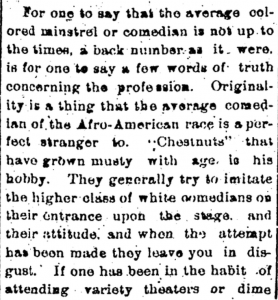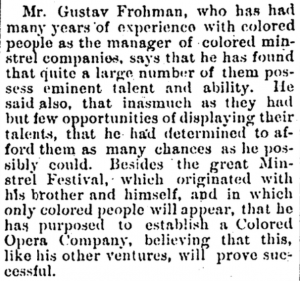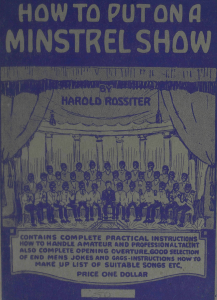In my search for primary sources, I came across three commentaries on minstrelsy that held very different views of black performers. Despite their differences, though, they all gave clear examples of an “us” and “them” mentality—a white “us” viewing a black “them” as “other”—betraying a deep racism even when praising black performers or not mentioning them at all.

From the Freeman1
The most overtly racist commentary I came across was in the newspaper the Freeman, in which the author writes that the average African American comedian is a “perfect stranger” to originality, instead trying to “imitate the higher class of white comedians,” an attempt which “leave[s] you in disgust.”1 Such a broad denial of African American talent is an obvious example of racist “us” and “them” thinking, in which the “us” is clearly much better than the “them.”
In contrast, the Cleveland Gazette shares a view that is very complimentary of black performers:

From the Cleveland Gazette2
Even this view, though, shows a blatant “us” and “them” mentality. Mr. Frohman’s authority is given by his having “many years of experience with colored people.” This implies that black performers are different enough from white performers that one must have extensive experience with them in order to hold such a view. This seems almost dehumanizing to me, as one would speak in the same way of having experience with a certain type of animal.

Cover of How to Put On a Minstrel Show3
Lastly, I was interested by the extent to which black performers were left unmentioned in How to Put On a Minstrel Show by Harold Rossiter. As black performers were a realistically viable option in minstrel shows, one would expect at least a mention of them in such a guide—which includes mentions of female performers—but it fails to do so. The word “negro,” for example, only appears three times: twice in advice against using too much negro dialect, and once in advice against choosing a song that would be “unusual for a negro minstrel to sing.” “Negro minstrel” seems to refer only to the race of the character, and not the race of the performer, as this comment leads into a discussion of the particular types of music appropriate for minstrel shows, independant of performer.3 This complete dismissal of black performers as possibilities shows a mentality that is so consumed by the “us” that the “them” does not even exist as an option—that they’re simply unmentioned speaks volumes.
On the surface, these three sources have very different views of black minstrel performers. All three, though, prove to be ultimately based in the same mentality that black performers are a “them” distinctly “other” from a white “us.” This mentality existing underneath and across such difference shows how widespread and ingrained this mentality was during the height of minstrelsy.
1 Freeman (Indianapolis, Indiana), March 8, 1890: 5. Readex: African American Newspapers. https://infoweb.newsbank.com/apps/readex/doc?p=EANAAA&docref=image/v2:12B28495A8DAB1C8@EANAAA-12BC6A86252E2C58@2411435-12BC14F72F342EC8@4.
2 Cleveland Gazette (Cleveland, Ohio), December 22, 1883: 2. Readex: African American Newspapers. https://infoweb.newsbank.com/apps/readex/doc?p=EANAAA&docref=image/v2:12B716FE88B82998@EANAAA-12CC2D3DD2BAB938@2409167-12CBE5C758F47D20@1.
3 Rossiter, Harold. How to Put On a Minstrel Show. Chicago: Max Stein Publishing House, 1921. https://infoweb.newsbank.com/iw-search/we/Evans/?p_product=EAIX&p_theme=eai&p_nbid=M4FE57BMMTU3MDA2NjY5OS4zMzQ1MzU6MToxNDoxOTkuOTEuMTgwLjE5Nw&p_action=doc&p_queryname=page3&f_qdnum=6&f_qrnum=543&f_qname=8&f_qnext=v2%3A13D59FCC0F7F54B8%40EAIX-147E02DCC3485118%408215&f_qprev=v2%3A13D59FCC0F7F54B8%40EAIX-147E02BD74B69930%402721&p_docref=v2:13D59FCC0F7F54B8@EAIX-154E9B0050389E50@S1879-1606D6241581936C@0.
